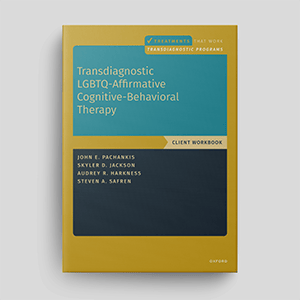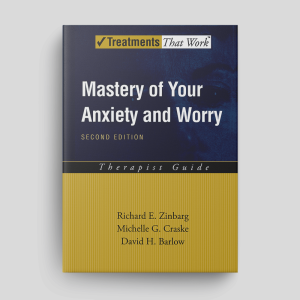Transdiagnostic LGBTQ-Affirmative Cognitive-Behavioral Therapy: Therapist Guide
The Transdiagnostic LGBTQ-Affirmative Cognitive-Behavioral Therapy program provides step-by-step instructions and evidence-based strategies to address the unique mental health challenges of LGBTQ+ individuals. A client workbook is downloadable separately.
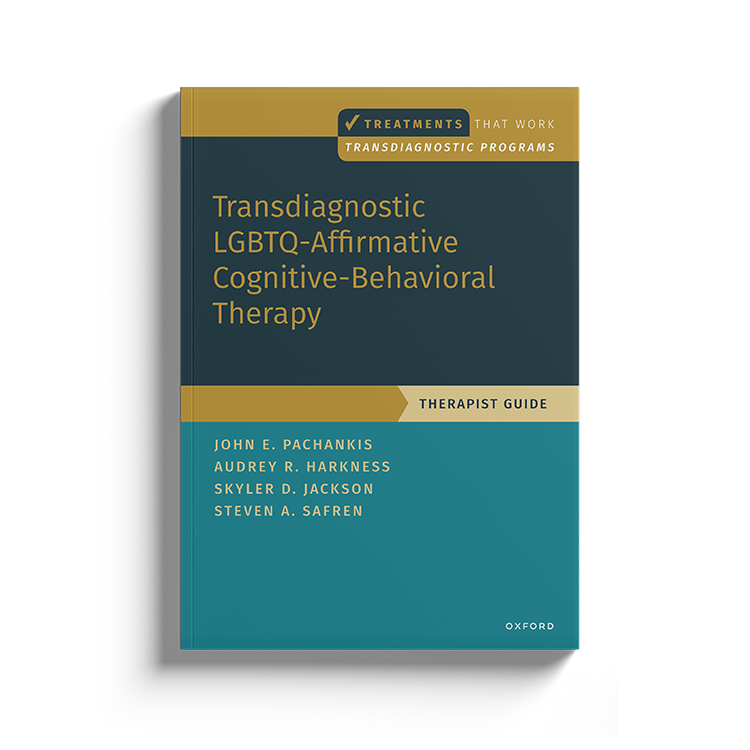
Download or send
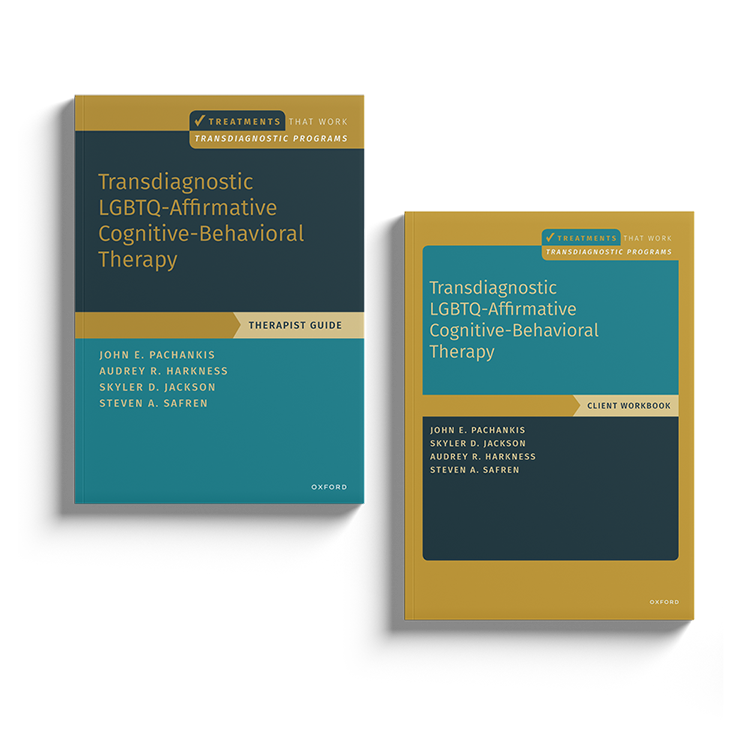
Overview
LGBTQ-affirmative cognitive behavioral therapy (CBT) blends standard CBT methods with minority stress theory to meet the mental health needs of LGBTQ+ individuals. Drawing on the Unified Protocol For Transdiagnostic Treatment Of Emotional Disorders, minority stress research, and community input, it addresses the effects of stigma, discrimination, and internalized bias. Recognizing that elevated rates of depression, anxiety, and substance use are linked to rejection, concealment, and internalized homonegativity, this approach validates distress as a natural response to systemic adversity. It promotes coping strategies such as mindfulness, assertiveness, cognitive flexibility, and social support. The therapy also targets intersectional stressors, helping clients challenge unhelpful beliefs, regulate emotions, and build authentic relationships. Research shows it effectively reduces depression, anxiety, substance use, and minority stress. This framework supports clinicians in delivering affirming, evidence-based care that builds resilience and improves mental health across diverse LGBTQ+ populations.
Why use this resource?
This program provides a step-by-step, structured approach for the specific experiences of LGBTQ+ clients, ensuring that therapy is both affirmative and effective.
- Provides practical guidance for structuring sessions and implementing client exercises.
- Helps clients understand and address LGBTQ-related stressors.
- Outlines structured interventions tailored to common challenges related to LGBTQ+ mental health.
- Supports clinicians in delivering affirmative therapy in individual and group settings.
Key benefits
Affirmative
Comprehensive
Structured
Trusted
What difficulties is this for?
LGBTQ+ clients
LGBTQ+ individuals who are struggling with their mental health.
Theoretical background and therapist guidance
The Transdiagnostic LGBTQ-Affirmative Cognitive Behavioral Therapy program described in this guide represents an innovative adaptation of established cognitive behavioral therapy (CBT) principles to address the unique mental health challenges faced by LGBTQ+ individuals. While traditional CBT has been rigorously validated for a range of emotional disorders (Hofmann et al., 2012), it has historically paid little attention to the specific stressors associated with sexual and gender minority identities. This guide bridges that gap by integrating CBT techniques with minority stress theory (Meyer, 2003), offering a tailored intervention to mitigate the disproportionate burden of mental health issues experienced by LGBTQ+ populations (King et al., 2008; Bränström et al., 2020).
Research consistently highlights the elevated risk of depression, anxiety, substance use, and other emotional difficulties among LGBTQ+ individuals compared to cisgender and heterosexual populations (Mays & Cochran, 2001; Rodriguez-Seijas et al., 2019). These disparities are largely attributed to minority stress, which encompasses social stigma, discrimination, internalized homonegativity, and chronic stress responses. For example, experiences of rejection, concealment of identity, and internalized societal bias have been linked to psychological distress, self-esteem issues, and maladaptive coping behaviors (Hatzenbuehler, 2009; Pachankis, 2014). The chronic nature of minority stress means these challenges often persist across the lifespan, impacting not only mental health but also interpersonal relationships and overall quality of life (Newcomb & Mustanski, 2010).
This guide draws on three key sources to address these challenges:
- The Unified Protocol For Transdiagnostic Treatment Of Emotional Disorders (Barlow et al., 2017b). This CBT-based framework targets shared vulnerabilities across emotional disorders, such as high negative affect, maladaptive cognitive appraisals, and avoidance of uncomfortable emotions (Barlow et al., 2014).
- Minority Stress Theory (Meyer, 2003). This theory provides a conceptual framework for understanding how societal stigma contributes to the heightened prevalence of mental health issues in LGBTQ+ populations.
- Expert and Community Feedback. Input from mental health providers and LGBTQ+ community members informed the adaptation of CBT techniques to specifically address LGBTQ-related stress (Pachankis et al., 2020c; Scheer et al., 2022).
The approach emphasizes normalizing emotional distress as a valid response to external stigma rather than a personal failing. LGBTQ-Affirmative CBT helps clients:
- Develop mindful awareness of their emotions (Barlow et al., 2014).
- Challenge maladaptive beliefs rooted in LGBTQ-related stress, such as feelings of inferiority or unworthiness (Millar et al., 2016).
- Build assertive behaviors and authentic self-expression to counteract disempowerment (Jackson et al., 2021).
- Strengthen interpersonal relationships and social support networks as protective factors against stress (Pachankis et al., 2008; Newcomb & Mustanski, 2010).
Research indicates that LGBTQ-Affirmative CBT has substantial benefits, especially among gay and bisexual men, with studies indicating moderate-to-large reductions in depressive symptoms, anxiety, and substance use, alongside improved emotion regulation and social support (Pachankis et al., 2015; 2022). Adaptations for sexual minority women have similarly shown reductions in depressive and anxiety symptoms (Scheer et al., 2022). Group applications also proved effective, particularly for Black and Latinx gay and bisexual men, who reported significant improvements in mental health (Jackson et al., 2021). Early findings suggest its effectiveness in non-Western contexts as well (Pan et al., 2020).
The program includes two books:
- Transdiagnostic LGBTQ-Affirmative Cognitive-Behavioral Therapy: Therapist Guide
- Transdiagnostic LGBTQ-Affirmative Cognitive-Behavioral Therapy: Workbook
Authored by leading psychologists including David Barlow, Michelle Craske and Edna Foa, Treatments That Work™ is a series of manuals and workbooks based on the principles of cognitive behavioral therapy (CBT). Each pair of books (Therapist/Clinician Guide and Workbook) – contains step-by-step procedures for delivering evidence-based psychological interventions and will help you to provide the best possible care for your clients.
At Psychology Tools, we are proud to make many of the Treatments That Work™ titles available to our members. Each book is available to download chapter-by-chapter, and Psychology Tools members with a currently active subscription to our ‘Complete’ plan are licensed to share copies with their clients.
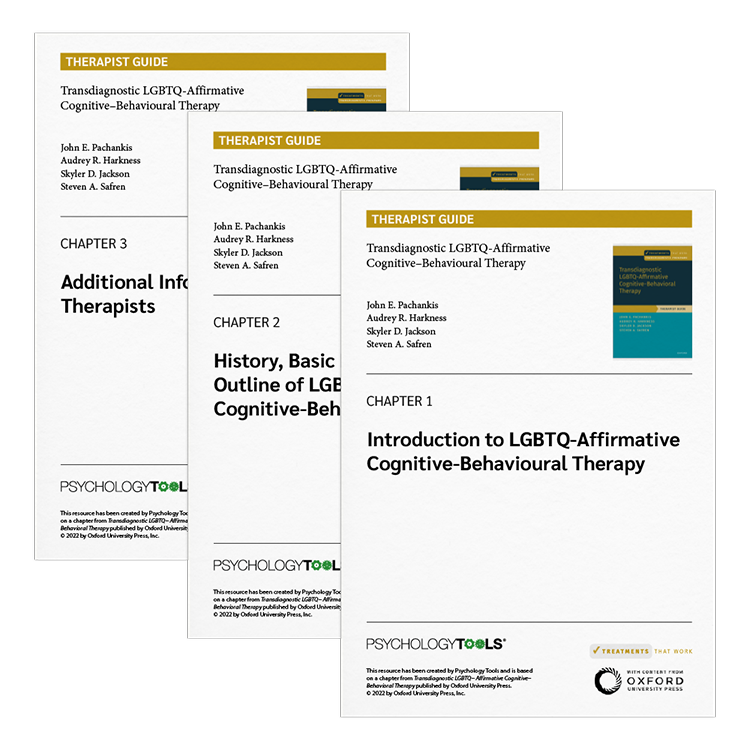
What's inside
- A structured, session-by-session treatment manual.
- Therapist checklists and progress monitoring tools.
- Detailed guidance for implementing cognitive-behavioral interventions with LGBTQ individuals.
- Case examples and troubleshooting tips for common challenges.
FAQs
How this resource helps improve clinical outcomes
By using this resource, clinicians can:
- Provide evidence-based, affirmative care to LGBTQ+ clients.
- Address minority stress in a structured, therapeutic framework.
- Foster identity-affirming, supportive therapeutic relationships.
- Tailor treatment to meet individual needs.
References and further reading
- Barlow, D. H. (2017). Unified Protocol for the Transdiagnostic Treatment of Emotional Disorders. Oxford University Press.
- Meyer, I. H. (2003). Prejudice, social stress, and mental health in lesbian, gay, and bisexual populations: Conceptual issues and research evidence. Psychological Bulletin, 129(5), 674–697.
- Pachankis, J. E. (2014). Uncovering clinical principles and techniques to address minority stress. Clinical Psychology: Science and Practice, 21(4), 313–330.
- Pachankis, J. E., Harkness, A. R., & Safren, S. A. (2022). Transdiagnostic LGBTQ-Affirmative Cognitive-Behavioral Therapy. Oxford University Press.
- Hatzenbuehler, M. L. (2009). How does sexual minority stigma “get under the skin”? A psychological mediation framework. Psychological Bulletin, 135(5), 707–730.
Just enter your name and email address, and we'll send you Transdiagnostic LGBTQ-Affirmative Cognitive-Behavioral Therapy: Therapist Guide (English US) straight to your inbox. You'll also receive occasional product update emails wth evidence-based tools, clinical resources, and the latest psychological research.
Product
Company
Support
- © 2026 Psychology Tools. All rights reserved
- Terms & Conditions
- Privacy Policy
- Cookies Policy
- Disclaimer
Working...
We value your privacy
This site uses strictly necessary cookies to function. We do not use cookies for analytics, marketing, or tracking purposes. By clicking “OK”, you agree to the use of these essential cookies. Read our Cookie Policy
